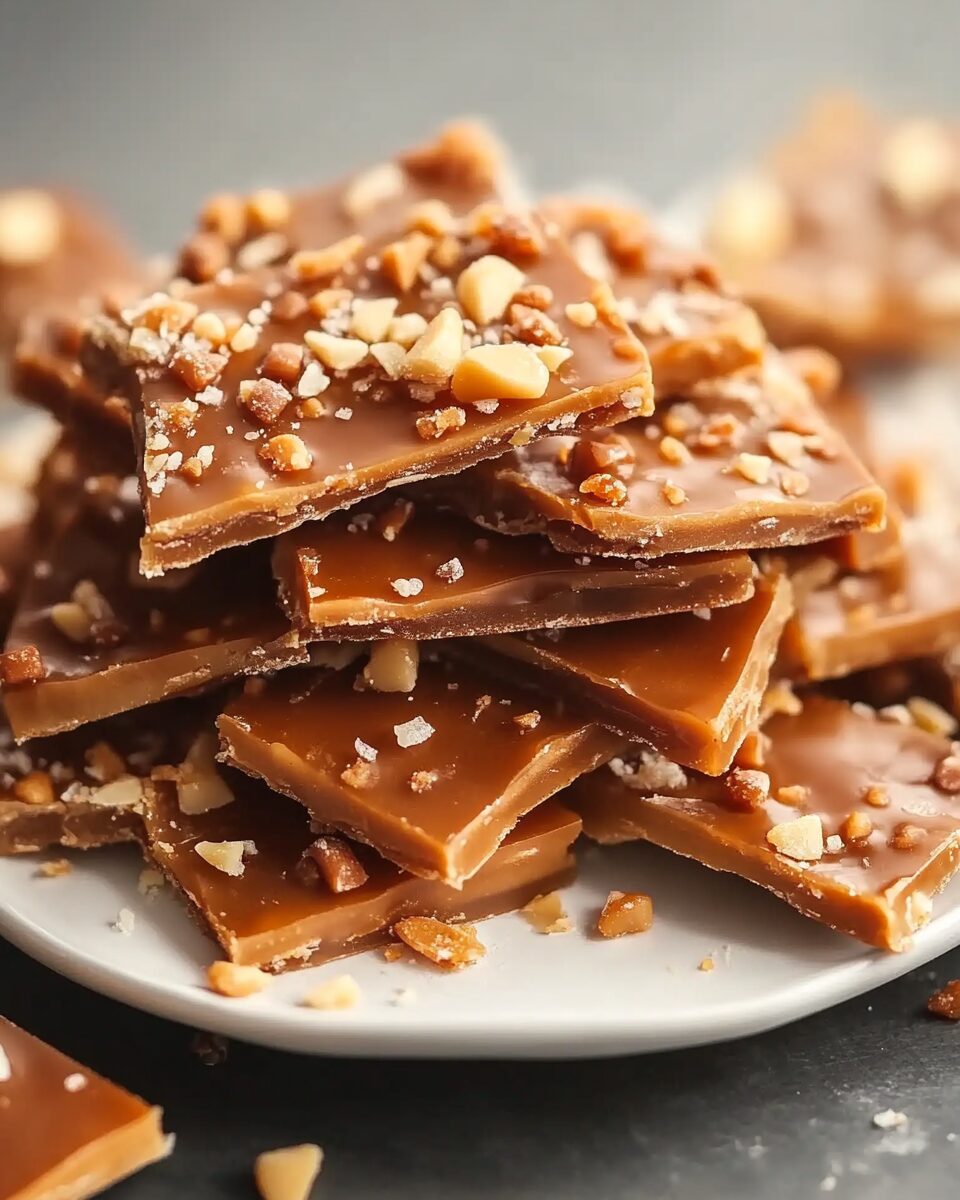Homemade toffee is a classic confectionery treat that strikes a delicious balance between rich, buttery sweetness and smooth chocolate. Perfect for gifting or simply indulging, this recipe is accessible for both beginners and seasoned bakers. With minimal ingredients and just a bit of patience, you can create a batch of crispy, golden toffee that rivals any store-bought variety. It’s ideal as a festive dessert, holiday gift, or a sweet snack.
Full Recipe:
Ingredients
-
1 cup (2 sticks) unsalted butter
-
1 cup granulated sugar
-
1/4 teaspoon salt
-
1 teaspoon pure vanilla extract
-
1 1/2 cups semi-sweet chocolate chips
-
1/2 cup chopped nuts (optional – almonds or pecans)
Directions
-
Prepare Your Workspace: Line a baking sheet with parchment paper or a silicone baking mat.
-
Melt the Butter: In a heavy-bottomed saucepan over medium heat, melt the butter. Add sugar and salt. Stir until smooth and bubbling.
-
Cook to the Hard Crack Stage: Cook, stirring occasionally, until the mixture reaches 300°F (150°C) on a candy thermometer (about 7–10 minutes). The color should be a rich golden brown.
-
Add Vanilla Extract: Remove from heat and carefully stir in vanilla extract—it may bubble.
-
Spread the Toffee: Pour onto the prepared sheet and spread evenly with a spatula.
-
Add the Chocolate Layer: Immediately sprinkle chocolate chips on top. Let them soften for a minute or two, then spread evenly.
-
Optional Nut Topping: If using, sprinkle chopped nuts over the soft chocolate layer.
-
Cool and Set: Let the toffee cool completely at room temperature, or refrigerate to speed things up.
-
Break and Serve: Once fully cooled and hardened, break into bite-sized pieces and enjoy.
Nutrients
-
Calories: 150 kcal
-
Total Fat: 10g
-
Saturated Fat: 6g
-
Trans Fat: 0g
-
-
Cholesterol: 20mg
-
Sodium: 50mg
-
Total Carbohydrates: 15g
-
Dietary Fiber: 0.5g
-
Sugars: 14g
-
-
Protein: 1g
What Makes Toffee So Irresistible
Toffee is all about contrast—crispy yet creamy, sweet but balanced, and smooth with a satisfying crunch. The magic begins with the golden base made from slowly cooked butter and sugar. As it cooks, the sugar caramelizes into a deep amber hue, infusing the toffee with complex, nutty undertones. Once poured and set, the toffee is topped with a layer of silky melted chocolate that creates a perfect snap when bitten into. Optional chopped nuts add texture and flavor, providing a delightful finish that enhances the richness of the base without overpowering it.
Perfect for Gifting and Sharing
Few homemade gifts are as well-received as a bag or tin of freshly made toffee. Its elegant look and indulgent flavor make it a favorite during holidays, birthdays, or special celebrations. Toffee stores well at room temperature in airtight containers, making it perfect for packaging as gifts or shipping to loved ones. Tie up pieces in cellophane bags or layer them in festive tins for a polished presentation that looks as good as it tastes. It’s a thoughtful, handmade gift that shows care and effort while being simple to prepare in batches.
Great for Beginners and Advanced Bakers Alike
While candy making can sometimes seem intimidating, homemade toffee is surprisingly accessible. You don’t need any special equipment beyond a good saucepan, a baking sheet, and a candy thermometer. The key to success is patience and timing—once you master the process of reaching the hard crack stage, the rest falls easily into place. The recipe is forgiving and adaptable, which makes it an ideal entry point for anyone looking to try their hand at homemade confections without diving into more complex recipes like fudge or nougat.
The Importance of Temperature in Toffee Making
When making toffee, achieving the right temperature is critical. The sugar and butter mixture needs to reach 300°F, known as the hard crack stage. This ensures the toffee sets properly, achieving that signature crunch and brittle texture. Using a candy thermometer takes the guesswork out and prevents burning or undercooking. Watching for the visual cue of the toffee turning a deep golden brown is also a helpful way to ensure you’re on track. Once you get comfortable with the process, you’ll find it becomes second nature, and you’ll be able to whip up batches with ease and confidence.
Chocolate and Nuts: Optional But Irresistible
The topping is where you can get creative with your toffee. A generous sprinkling of semi-sweet chocolate chips forms the rich, smooth upper layer that contrasts beautifully with the crisp toffee base. While this chocolate layer is classic, you can also experiment with milk or dark chocolate for a flavor variation. Nuts are an optional but highly recommended addition. Chopped almonds or pecans add a subtle crunch and a toasted, earthy note that elevates the entire experience. You can sprinkle them on top of the melted chocolate or even fold them into the toffee base before spreading—either way, they bring an irresistible complexity to each bite.
An Elegant Dessert or Anytime Treat
Toffee isn’t just a holiday indulgence—it’s an everyday luxury that works beautifully as a simple dessert or afternoon snack. Serve it with coffee or tea for a satisfying crunch between sips, or crumble it over ice cream for an easy yet decadent topping. It also makes a wonderful addition to dessert boards, cookie trays, or party platters, offering a contrast to softer desserts like truffles or caramels. Because it stores well, you can keep a stash on hand for whenever your sweet tooth strikes or unexpected guests arrive.
A Recipe That Invites Experimentation
Once you’ve mastered the basic method of making toffee, the possibilities for flavor customization are endless. Try infusing the butter with spices like cinnamon or cayenne for a warming or spicy twist. You can add a splash of bourbon or espresso for depth and complexity. Even a pinch of sea salt sprinkled over the chocolate layer before it sets can create an elevated, gourmet version that appeals to sophisticated palates. Don’t be afraid to get creative—the sturdy structure of toffee means it can handle bold flavors and still maintain its iconic texture.
Ideal for Make-Ahead and Storage
One of the most practical advantages of homemade toffee is how well it keeps. When stored in an airtight container at room temperature, it stays fresh and crisp for up to two weeks or longer. This makes it a fantastic make-ahead dessert for entertaining, especially during the busy holiday season. You can also refrigerate or freeze it if needed, though room temperature is best to maintain its snap and texture. It doesn’t soften easily, which means it travels well—perfect for packing into lunchboxes or sending in care packages.
A Crowd-Pleasing Favorite That Disappears Fast
Homemade toffee has universal appeal. Its buttery richness and classic flavor profile make it a favorite across generations. Whether you’re serving it at a family gathering or gifting it to friends and neighbors, it’s almost guaranteed to disappear quickly. Kids love the sweetness and crunch, while adults appreciate the nostalgic, homemade charm. It’s one of those rare treats that manages to feel indulgent and comforting at the same time. Once you’ve made it, you’ll find yourself returning to the recipe again and again.
Conclusion
Homemade toffee is the perfect blend of simplicity and indulgence. With just a few ingredients and a bit of patience, you can create a confection that’s crisp, buttery, and utterly irresistible. It’s ideal for gifting, snacking, or adding a touch of elegance to your dessert table. Whether you enjoy it plain, topped with chocolate, or sprinkled with nuts, toffee offers a satisfying crunch and rich flavor that never goes out of style. Make it once, and you’ll discover that this timeless treat is not only easy to master but endlessly enjoyable to share.






